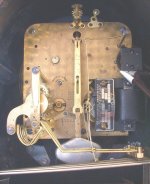Herschede - Revere Clocks
Walter Herschede and Henry Warren worked together in 1925 to produce an electric clock with chimes, resulting in a new line of clocks, called Revere Telechron, in 1926. These clocks were manufactured by Herschede, which can be seen in the photos below. Figures 1 and 2 show a Revere Model 100 (1929) large, two-plate movement:
 |
Fig. 1
 |
Fig. 2
Figure 3 shows a mechanical Herschede with Westminster chimes from the early 1920s.
 |
Fig. 3
The Revere clock was obviously based on this clock. Several Revere models were produced, including Model 120 with five tubular bells for grandfather clocks. These clocks were large, heavy, and obviously expensive. Below is one more example, a Herschede with a Telechron motor and a pendulum. This clock has Westminster and Canterbury chimes. It cost $91 in 1929. When you consider that a Model T Ford cost $256 in 1925, this mantel clock was probably cost-no-object engineering! Click on Figure 4 to view an enlargement, which will open in a new window.
 |
Fig. 4
There are no special instructions for servicing and adjusting these clocks because the adjustment of the chimes and strike is much the same as for equivalent mechanical clocks. Only two points need to be mentioned. The first point is that the lubricants in electric clocks tend to evaporate because the clock is not sealed and because the electric motor generates heat. Therefore the lubricants that work well in mechanical clocks may fail in electric clocks. The second point is that the chimes may not stop if a load is applied to the gears (in other words, a chime hammer is being lifted) at the moment the chimes are expected to stop.
Shortly after the introduction of Revere clocks, a new Model 100 single plate movement was introduced, probably around 1932, with the chimes and strike cleverly combined to reduce the number of parts needed, simplifying the design and reducing production costs considerably. The photos below show this movement. Most Revere clocks produced between 1932 and 1959 have this mechanism. Despite the reduction in size and cost, it works just as well as the more expensive models!
 |
Fig. 5
 |
Fig. 6
 |
Fig. 7
 |
Fig. 8
The chimes are activated when the lifting disc (see Figure 8), mounted on the center shaft, moves the lifting lever until the shifting lever engages the pin (J) on the gear arm. At the moment the lifting disc releases the lifting lever, the shifting lever pulls the gear arm to the left, so that the chime gear on the gear arm engages the center wheel. The clock chimes until the chime cam (or locking disc: see also Figure 5, A) lifts the release lever up, causing it to unlock the pin (J) from the shifting lever. The other pin (M) on the gear arm presses against the locking disc until the disc allows it to fall into a slot. If none of the chime hammers are being lifted at the moment the pin (M) is to fall into a slot in the locking disc, the gear arm moves to the right and disengages the chime gear from the center wheel and the chiming stops.
Adjusting the chimes, when assembling this clock, involves one simple step. As shown in Figure 9, put a wire through a small hole in the locking disc, through the hole in the movement plate, and through the hole in the chime cylinder drive gear (see also Figures 5, A and 7, A). Then tighten the screw on the locking disc.
Adjusting the strike involves two steps. Put the minute hand onto its post on the center shaft and move it to the hour ("60"). As shown in Figure 9 below, put a wire through a small hole in the back plate (or cylinder bridge) and through the hole in the hour control wheel. Then tighten the two screws on the hour setting wheel (also see Figures 5, B; 6, D; and 7, D).
 |
Fig. 9
There is a copper spring under the minute wheel (see Figure 5, C) which can be removed because it creates a lot of friction and wear. It is intended to keep the hands from moving slightly while the clock chimes. This slight movement does not bother me, so I have removed the copper springs from my Revere clocks.
While servicing a Revere clock, pay particular attention to the bearings of the second wheel (next to the motor) and the third wheel (the center shaft).
If you still have chime or strike problems after having made the adjustments outlined on this page, the repairs require a much deeper understanding of how this design works. You may need to find a repairman who has experience with Revere clocks, and who has an original Revere service manual. The reprint of the service manual available today provides a summary. Most repairmen resort to removing the mechanisms from electric clocks and inserting new plastic quartz mechanisms, which is a tragedy!
I hope that knowing more about Revere clocks, and that Revere clocks were made with the same attention to quality as their equivalent mechanical Herschede cousins, will make clock collectors become more interested in Revere clocks. An equivalent mechanical Herschede today sells for three to four times as much as a Revere clock. Old Revere clocks can therefore be acquired for bargain prices! Collectors should consider clocks with the two mechanisms shown on this page. These are the best and the most common models. In the 1950s, General Electric sold these clocks with their name on them, but the clocks were the same. Avoid other models, particularly those made after 1960, which were sold under the Herschede name, and which look considerably different and less substantial.
Click on the small image below to view setup instructions for the Model 100 single plate movement.
|
 |
Clock Repair Main Page
Escapements in Motion
Links Page
Tributes Page
